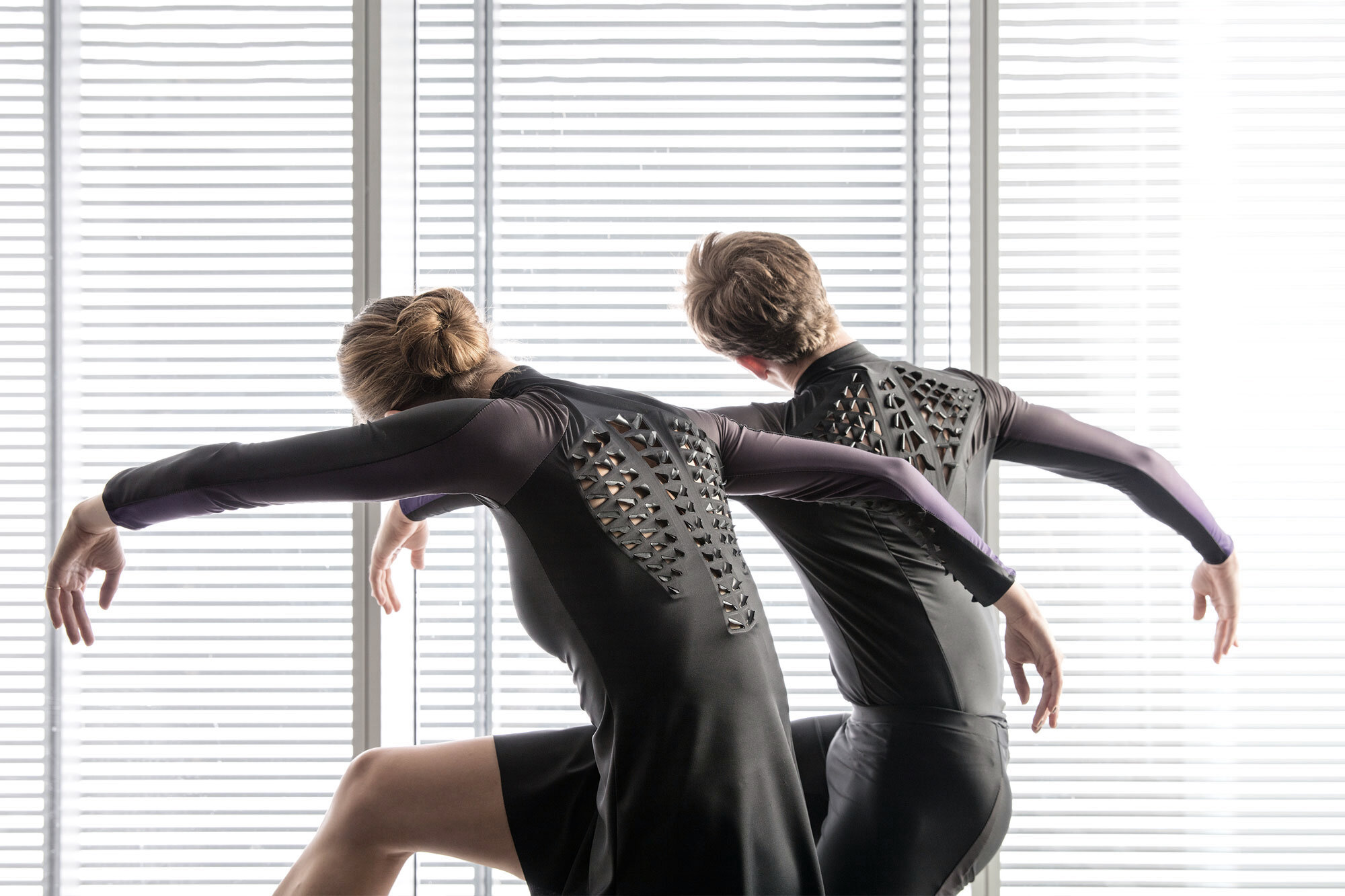
bioLogic: Natto Cells as Nanoactuators for Breathing Second Skin
2014-2017
Nature has engineered its own actuators, as well as the efficient material composition, geometry and structure needed to utilize its actuators and achieve functional transformation. Based on the natural phenomenon of cells’ hygromorphic transformation, we introduce the living Bacillus Subtilis natto cell as a humidity-sensitive nanoactuator. bioLogic is growing living actuators and synthesizing responsive bio-skin in the era where bio is the new interface.
This project was conducted at Tangible Media Group, MIT Media Lab, where Prof. Lining Yao was finishing her doctoral dissertation.
By Lining Yao, Wen Wang, Guanyun Wang, Helene Steiner, Chin-Yi Cheng, Jifei Ou, Oksana Anilionyte, Hiroshi Ishii (Originally Conducted at MIT)
Publications:
Science Advances 2017 PDF | DOI;
3D Printing and Additive Manufacturing 2015 PDF | DOI;
ACM CHI 2015 PDF | DOI;
ACM CHI 2016 PDF | DOI;
Book Chapter PDF | DOI.
Awards: 2015 CHI Full Paper | Best Talk Award | Best Paper Nominee | Fast Co.Design 2016 Innovation By Design Award , 2016 Platinum A’ Design Award for Textile, Fabric, Textures, Patterns and Cloth Design Category , 2016 Golden A’ Design Award for Wearable Technologies Design Category, 2016 Silver A’ Design Award for Fashion, Apparel and Garment Design Category
News: MIT News | Wired | Wired UK | Discovery News | Dezeen | YAHOO! News UK | CNBC | Fast Company | Creative Application, Gizmodo, Smithsonian Innovation, Interesting Engineer
Exhibitions: Center Pompidou | Ars Electronica | MIT Museum | Boston Museum of Fine Art
We are Imagining a world where actuators and sensors can be grown rather than manufactured, being derived from nature as opposed to engineered in factories.
A millennium ago, a Japanese samurai’s quest into battle took an unexpected turn. An abrupt attack in the midst of an evening meal led to a surprising culinary discovery. What was found on his journey was a previously undiscovered bacteria, Bacillus Subtilis Natto. The microorganism lived inside dry rice stalks, which were woven into bags to carry soybeans in that age. Ever since this coincidental discovery, the mysterious bacteria has become an established fermentation tool for the preparation of nattō, a soybean-based dish in Japan.
A thousand years into the future, a new behavior of the ancient bacteria has been unearthed: the expansion and contraction of the natto cells relative to atmospheric moisture. Enchanted by this phenomenon, a quest into the redefinition of actuation has become the ambition of the bioLogic team.
bioLogic seeks a harmonious perspective, where biological and engineering approaches flow in sync.
These animate cells are harvested in a bio lab, assembled by a micron-resolution bio-printing system, and transformed into responsive fashion, a “Second Skin”. We can now observe the self-transforming biological skin activated by living bacteria. The synthetic bio-skin reacts to body heat and sweat, causing flaps around heat zones to open, enabling sweat to evaporate and cool down the body through an organic material flux. In collaboration with New Balance, bioLogic is bringing what once may have lived in the realm of fantasies into the world of sportswear.
The creation process:
Beyond “Second Skin”, the bio-hybrid film can be utilized in other contexts as well: Bio-hybrid flowers blossom and wilt reversible with both shape and color changing; a living tea leaf signals through transformation when the tea is ready; or a lampshade sculpts light activated by the light bulb. Imagination unfolds the power of the tiny bacteria.
We demonstrate that the hygroscopic and biofluorescent behaviors of living cells can be engineered to design bio-hybrid wearable devices responding to environmental humidity gradients. Cells' biomechanical responses to external stimuli have been intensively studied but rarely implemented into devices that interact with human body. Here, we demonstrate that the hygroscopic and biofluorescent behaviors of living cells can be engineered to design bio-hybrid wearable devices, which give multifunctional responsiveness to the sweat of a human body. By depositing genetically-tractable microbes on a humidity-inert material to form a heterogeneous multi-layered structure, we obtained bio-hybrid films that can reversibly change shape and biofluorescence intensity within a few seconds in response to environmental humidity gradients. Experimental characterization and mechanical modelling of the film were performed to guide the design of a wearable running suit and a fluorescent shoe prototype with bio-flaps that dynamically modulates ventilation in synergy with the body's need for cooling.We use genetically modified living cells as our hygromorphic material units. The genetically modified E. coli cells carry biofluorescence. We quantified the change in fluorescence intensity in response to relative humidity. It transpired that the intensity decreased linearly as the relative humidity increased. A linear relationship between the intensity in fluorescence and the bending angle was also noted.
Publications: Science Advances PDF | DOI
Harnessing the Hygroscopic and Biofluorescent Behaviors of Genetically-Tractable Microbial Cells to Design Bio-hybrid Wearables
We developed a bioprinting platform to template living cells. bioPrint was developed for Bacillus Subtillis endospore deposition. Compared with other bioprinters used in bio labs today, our printer has a number of distinct functions that have been customized for our specific needs: clogging is prevented through the use of a special progressive pump-based dispenser; the printer has fast movement; it prints with a relatively low resolution of a hundred microns rather than at a submicron resolution, since the application we focused on was at human scale; it does not need a controlled sterile environment, since we do not expect the spores to grow once the film has been produced. bioPrint contains off-the-shelf hardware components and a software platform developed on top of open source plugins. bioPrint was designed with a few primary goals in mind: an easy workflow, starting from geometric design to G-code generation, to machine control to material fabrication; a high-precision deposition system for droplets ranging in width from 10 um up to 5mm; suitability for a large set of diverse user groups, including designers, artists, and scientists.We developed a standard, easy-to-follow process to prepare the printing solution. The optical density, which is directly related to the cell density, is critical for the printing success.We printed a lamp with bioPrint. The lampshade can be triggered by the heat from the light bulb, and transform to modulate the lighting pattern.
Publications:
Journal - 3D Printing and Additive Manufacturing 2015 PDF | DOI "
bioPrint: A Liquid Deposition Printing System for Natural Actuator
ACM CHI 2016 PDF | DOI
xPrint: A Modularized Liquid Printer for Smart Materials Deposition
Thanks to:
Supporting fashion concept developer / trend forecaster
Alana Solá, Fashion Designer. Email
Sponsors
New Balance
Council for the Arts at MIT
Dubai Design Week 2015
Scientific Support
Prof. Ozgur Sahin
Xi Chen
Prof. Rohit Karnik
Da Lu
Prof. Xuanhe Zhao
Teng Zhang
Kang Zhou

























